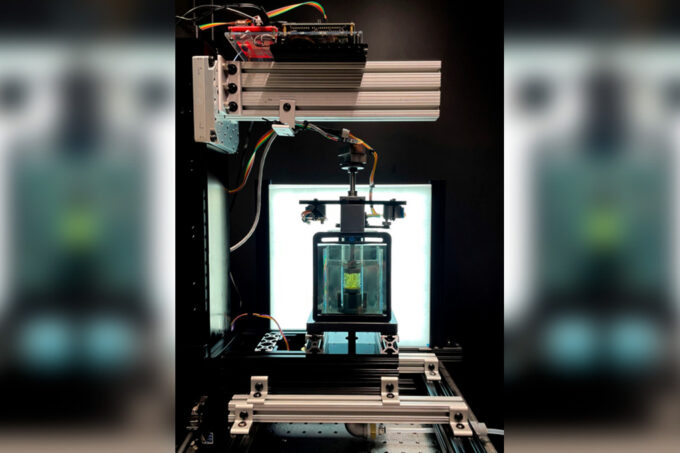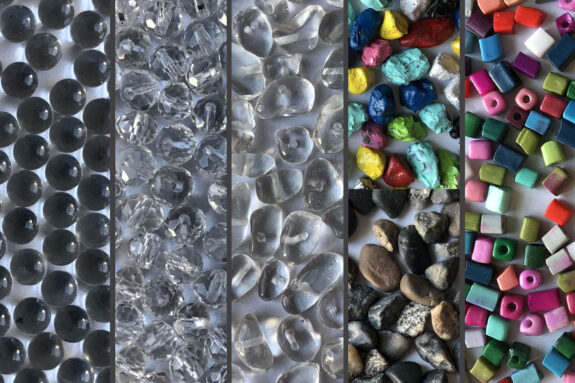With a new experimental technique, MIT engineers probe the mechanisms of landslides and earthquakes
Granular materials, those made up of individual pieces, whether grains of sand or coffee beans or pebbles, are the most abundant form of solid matter on Earth. The way these materials move and react to external forces can determine when landslides or earthquakes happen, as well as more mundane events such as how cereal gets clogged coming out of the box. Yet, analyzing the way these flow events take place and what determines their outcomes has been a real challenge, and most research has been confined to two-dimensional experiments that don’t reveal the full picture of how these materials behave.
Now, researchers at MIT have developed a method that allows for detailed 3D experiments that can reveal exactly how forces are transmitted through granular materials, and how the shapes of the grains can dramatically change the outcomes. The new work may lead to better ways of understanding how landslides are triggered, as well as how to control the flow of granular materials in industrial processes. The findings are described in the journal PNAS in a paper by MIT professor of civil and environmental engineering Ruben Juanes and Wei Li SM ’14, PhD ’19, who is now on the faculty at Stony Brook University.

From soil and sand to flour and sugar, granular materials are ubiquitous. “It’s an everyday item, it’s part of our infrastructure,” says Li. “When we do space exploration, our space vehicles land on granular material. And the failure of granular media can be catastrophic, such as landslides.”
“One major finding of this study is that we provide a microscopic explanation of why a pack of angular particles is stronger than a pack of spheres,” Li says.
Juanes adds, “It is always important, at a fundamental level to understand the overall response of the material. And I can see that moving forward, this can provide a new way to make predictions of when a material will fail.”
Scientific understanding of these materials really began a few decades ago, Juanes explains, with the invention of a way to model their behavior using two-dimensional discs representing how forces are transmitted through a collection of particles. While this provided important new insights, it also faced severe limitations.
In previous work, Li developed a way of making three-dimensional particles through a squeeze-molding technique that produces plastic particles that are free of residual stresses and can be made in virtually any irregular shape. Now, in this latest research, he and Juanes have applied this method to reveal the internal stresses in a granular material as loads are applied, in a fully three-dimensional system that much more accurately represents real-world granular materials.
These particles are photoelastic, Juanes explains, which means that when under stress, they modify any light passing through them according to the amount of stress. “So, if you shine polarized light through it and you stress the material, you can see where that stress change is taking place visually, in the form of a different color and different brightness in the material.”
Such materials have been used for a long time, Juanes says, but “one of the key things that had never been accomplished was the ability to image the stresses of these materials when they are immersed in a fluid, where the fluid can flow through the material itself.”
Being able to do so is important, he stresses, because “porous media of interest — biological porous media, industrial porous media, and geological porous media — they often contain fluid in their pore spaces, and that fluid will be hydraulically transported through those pore openings. And the two phenomena are coupled: how the stress is transmitted and what the pore fluid pressure is.”
The problem was, when using a collection of two-dimensional discs for an experiment, the discs would pack in such a way as to block the fluid completely. Only with a three-dimensional mass of grains would there always be pathways for the fluid to flow through, so that the stresses could be monitored while fluid was moving.
Using this method, they were able to show that “when you compress a granular material, that force is transmitted in the form of what we would call chains, or filaments, that this new technique is able to visualize and depict in three dimensions,” Juanes says.
To get that 3D view, they use a combination of the photoelasticity to illuminate the force chains, along with a method called computed tomography, similar to that used in medical CT scans, to reconstruct a full 3D image from a series of 2,400 flat images taken as the object rotates through 360 degrees.
Because the grains are immersed in a fluid that has exactly the same refractive index as the polyurethane grains themselves, the beads are invisible when light shines through their container if they are not under stress. Then, stress is applied, and when polarized light is shone through, that reveals the stresses as light and color, Juanes says. “What’s really remarkable and exciting is that we’re not imaging the porous medium. We’re imaging the forces that are transmitted through the porous medium. This opens up, I think, a new way to interrogate stress changes in granular materials.” He adds that “this has really been a dream of mine for many years,” and he says it was realized thanks to Li’s work on the project.
Using the method, they were able to demonstrate exactly how it is that irregular, angular grains produce a stronger, more stable material than spherical ones. While this was known empirically, the new technique makes it possible to demonstrate exactly why that is, based on the way the forces are distributed, and will make it possible in future work to study a wide variety of grain types to determine exactly what characteristics are most important in producing stable structures, such as the ballast of railroad beds or the riprap on breakwaters.
Because there has been no way to observe the 3D force chains in such materials, Juanes says, “right now it is very difficult to make predictions as to when a landslide will occur precisely, because we don’t know about the architecture of the force chains for different materials.”
It will take time to develop the method to be able to make such predictions, Li says, but that ultimately could be a significant contribution of this new technique. And many other applications of the method are also possible, even in areas as seemingly unrelated as how fish eggs respond as the fish carrying them moves through the water, or in helping to design new kinds of robotic grippers that can easily adapt to picking up objects of any shape.
The work was supported by the U.S. National Science Foundation.




